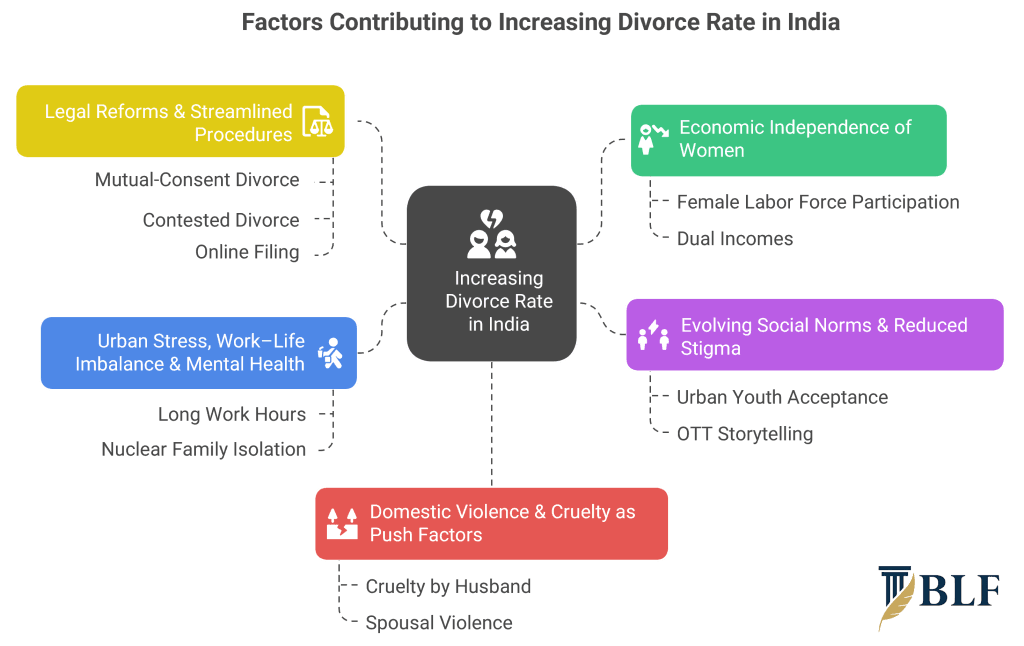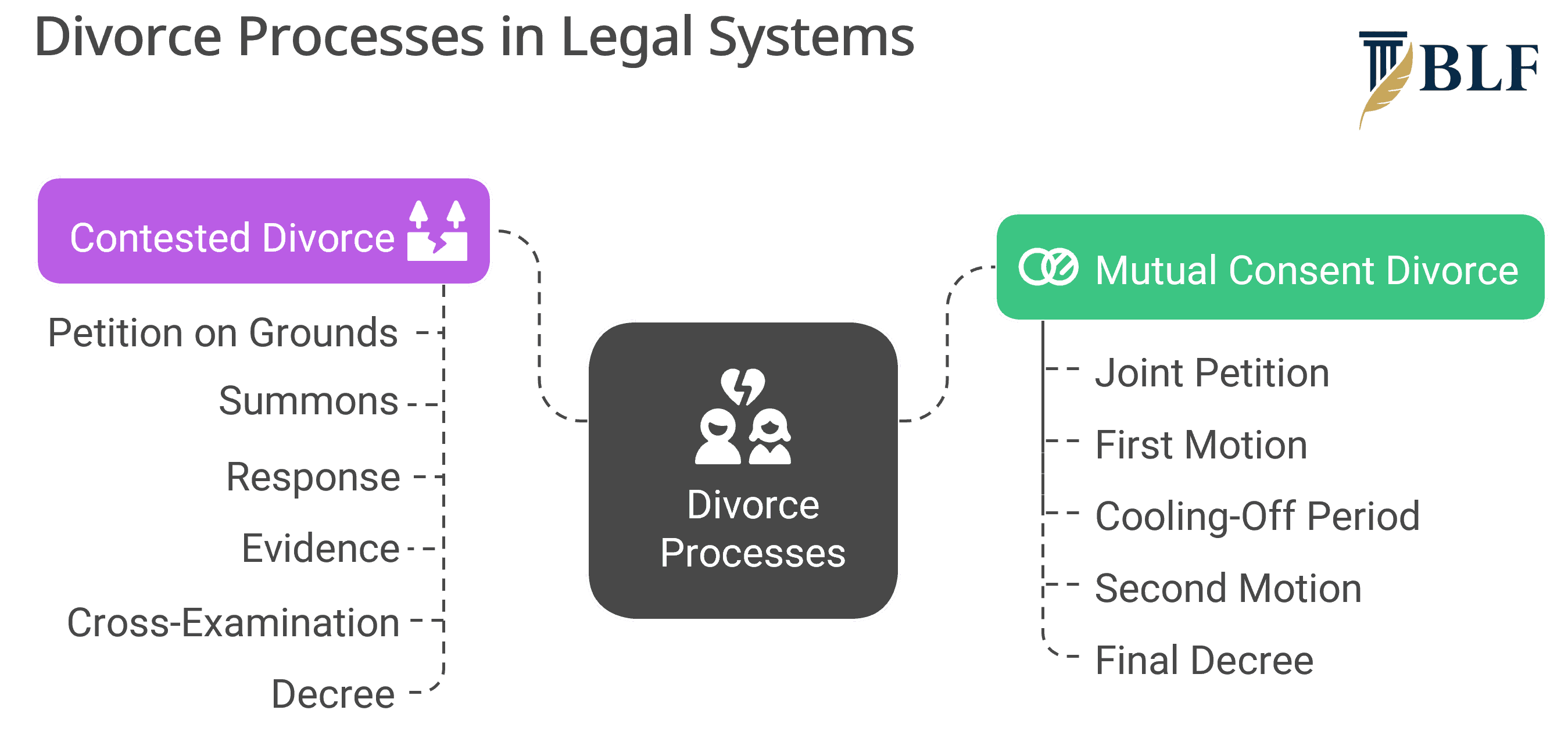Why Divorce Rate is Increasing in India: 5 Key Reasons
India’s divorce rate remains low by global standards – just 0.01 divorces per 1,000 people, or roughly 1.36 million divorced individuals nationwide – but the upward trajectory is unmistakable. In other words, marriage in India is still largely a lifelong commitment… unless one too many fights over the TV remote tips the scale.
In 2022, divorce petitions reached record highs in several states, signaling profound social, economic, and legal shifts. Turns out, even the sacred saath pheras can’t always withstand the combined force of career stress, financial independence, and in-laws with strong opinions.
This growing trend has raised an important question: Why divorce rate is increasing in India despite its traditionally strong family values and societal pressures against separation? Is it modern love losing its battery mid-journey — or simply people deciding not to suffer in silence for the sake of matching wedding albums?
In this blog post, we explore five primary drivers behind the rise in divorce filings in 2025, enriched with state-wise trends, demographic analysis, legal procedures, and actionable guidance for couples navigating marital challenges. Whether you’re married, unmarried, or just married to your job — there’s insight here for everyone.
Quick Statistics Snapshot:
| Metric | Figure | Source |
|---|---|---|
| Crude divorce rate | 0.01 per 1,000 population | Cision |
| Total divorced population | 1.36 million | BBC (Sep 2016) |
| Female labour – force participation (age 15+) | 41.7% (2023–24) | PLFS 2023–24 |
| Married women ever experiencing spousal violence | 29.3% | NFHS – 5 |
| “Cruelty by husband or relatives” share of crimes against women | 31.4% | NCRB 2022 (Newsclick Study) |
| Top three states by share of national divorce cases | Maharashtra 18.7%; Karnataka 11.7%; Delhi 7.7% | India TV News (July 4, 2025) |
| Median age at first marriage (women 20–49) | 19.2 years (2019–21) | The New Indian Express (2022) |

Why Divorce Rate is Increasing in India?
As the country continues to evolve – socially, economically, and legally – the nature of relationships is also undergoing significant change.
Understanding why divorce is becoming more common is essential for couples, families, and society at large. The following sections present the five real reasons why divorce rates are increasing across India.

1. Economic Independence of Women
As more women enter the workforce and attain financial autonomy, the economic barriers to leaving unsatisfying marriages disappear.
With their own incomes, women are empowered to exit unhappy unions rather than remain due to financial dependence.
- Female labour – force participation jumped from 23.3% in 2017–18 to 41.7% in 2023–24, nearly doubling in six years. (Source: PLFS)
- Dual incomes raise household standards but also heighten expectations for marital equity; unmet expectations often precipitate separation.

Source: CEDA
2. Evolving Social Norms & Reduced Stigma
Urbanisation, OTT storytelling, and social – media discourse are reframing divorce from taboo to personal choice.
- Urban youth surveys report growing acceptance: even people in metro cities view divorce as an option for well – being.
- Dramatic arcs on streaming platforms normalize separation and second marriages, softening community backlash.
3. Legal Reforms & Streamlined Procedures
Overview of divorce pathways under Hindu Marriage Act:
| Type | Key Features |
|---|---|
| Mutual – Consent Divorce | Joint petition → first motion → six – month cooling – off (waivable by higher courts under Article 142) → second motion within 18 months → final decree. |
| Contested Divorce | Petition on grounds (cruelty, adultery, desertion ≥2 years, mental disorder, etc.) → summons → response → evidence → cross – examination → decree (3–5 years on average). |
| Online Filing (E – Courts) | Pilot portals in Delhi/Mumbai enable digital submissions, reducing delays, travel, and procedural burdens. |
| Digital Evidence | Courts accept chat logs, emails, and social – media records to prove cruelty/adultery. |
Impact: E-courts and more flexible waiting periods have made legal relief more accessible to couples.

4. Urban Stress, Work–Life Imbalance & Mental Health
Metro professionals face 50+ hour workweeks, congested commutes, and nuclear – family isolation without elder support.
- Bengaluru family courts attribute rising petitions among 20–35 year – olds to “materialistic love,” burnout, and thinning social bonds.
- Unaddressed anxiety, depression, and digital distractions erode communication and emotional intimacy.
5. Domestic Violence & Cruelty as Push Factors
Key data:
- “Cruelty by husband or relatives” accounted for 31.4% of crimes against women in 2022.
- NFHS – 5 finds 29.3% of married women aged 18–49 report spousal violence, physical or emotional, at least once.
Legal recourse: Section 498A IPC allows women to seek protection orders and pursue divorce on cruelty grounds, bolstering separations from abusive homes.
To understand how courts evaluate such cases, explore how cruelty serves as valid legal grounds for divorce in India.
Regional & Community Variations
| State | Share of National Divorce Cases | Commentary |
|---|---|---|
| Maharashtra | 18.7% | Mumbai’s cosmopolitan milieu and evolving gender roles fuel filings. |
| Karnataka | 11.7% | Bengaluru’s IT stressors and dual – income demographics drive petitions. |
| Delhi | 7.7% | The national capital sees high mutual – consent rates via e – courts. |
| Tamil Nadu | 7.1% | Chennai’s professional class cites work stress and lifestyle discord. |
| Kerala | 6.3% | High literacy coexists with cultural emphasis on marital stability. |
Northern states (UP, Bihar, Rajasthan) still record low divorce shares (<3%) due to patriarchal norms and rural settings.
Source: India TV News
Impact on Families & Children
- High – conflict marriages inflict greater trauma on children than single – parent homes with amicable co – parenting.
- Psychosocial support: Counselling and mediation can mitigate emotional fallout, promoting healthier separations.
In some situations, couples may reconsider their decision to separate. To understand the legal process involved in reversing such a decision, read this guide on withdrawing divorce proceedings.
Early – Intervention & Prevention Strategies
- Monthly check-ins: Structured “relationship audits” to address grievances early.
- Joint financial planning: Transparent budgets to defuse money – related mistrust.
- Accessible therapy: Subsidized couple counselling before conflicts escalate.
Practical Checklist for Couples Considering Separation
- Documents to prepare: Marriage certificate, address proofs, bank statements, property deeds.
- Asset documentation: Photographic inventory of valuables for equitable division.
- Interim support: Agreement on child maintenance and spousal alimony to prevent sudden financial gaps.
- Legal consultation: Engage specialised family – law advocate early for tailored guidance.
Looking for Guidance on Divorce or Reconciliation?
If you’re navigating the complexities of divorce — from withdrawing a petition to understanding if and how a divorce can be reversed — the right legal support matters.
Bhatla Law Firm offers experienced, compassionate counsel for individuals and couples dealing with divorce and related family matters. As a leading divorce lawyer in Delhi, we provide practical legal solutions tailored to your unique circumstances.
Contact us today for a confidential consultation.
Website: bhatlalawfirm.com | Email: info@bhatlalawfirm.com | Maps: Based in Delhi
Conclusion
The rise in India’s divorce rate reflects deeper societal transformations—women’s economic empowerment, shifting norms, streamlined legal access, urban pressures, and heightened reporting of domestic violence.
Understanding why divorce rate is increasing in India is crucial for individuals, counsellors, and policymakers to address the root causes, fostering healthier unions and dignified separations.
By recognizing the five key reasons outlined here, stakeholders can champion early interventions, robust support systems, and informed choices—whether to reconcile or to part ways.

One Comment